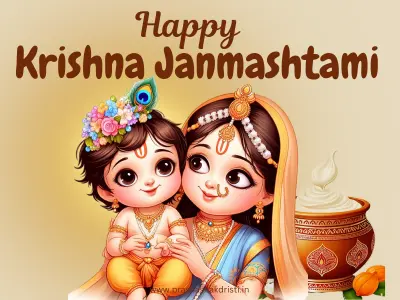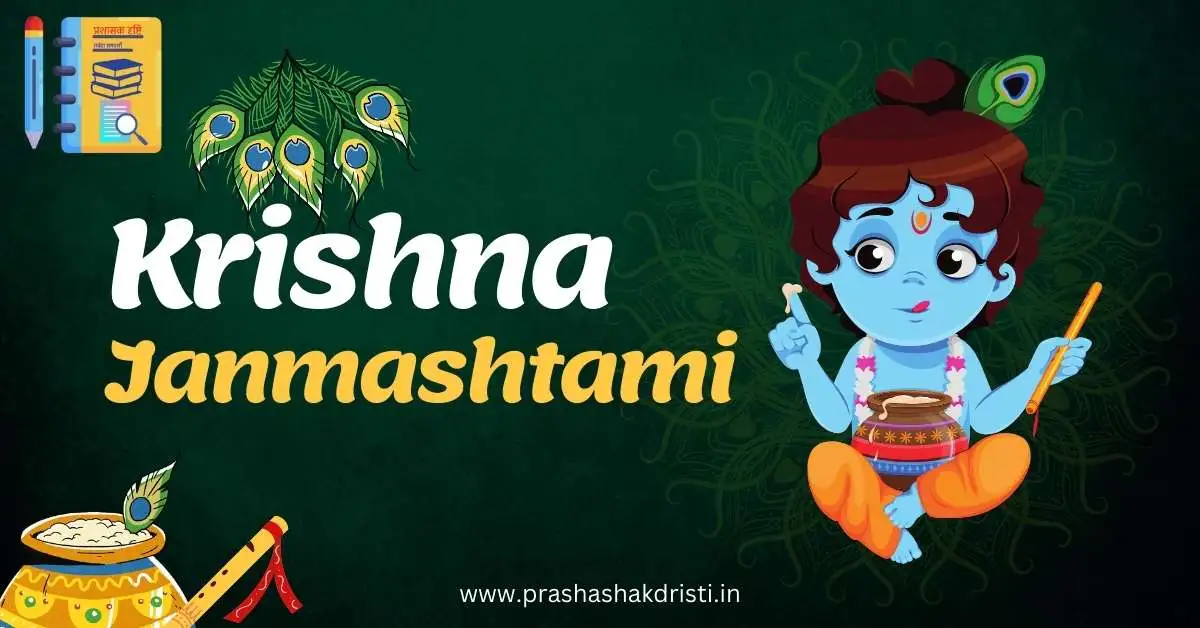Krishna Janmashtami is among the most extensively observed festivals in India. It commemorates the birth of Lord Krishna, who is regarded as an avatar of Lord Vishnu. This festival is celebrated on the eighth day (Ashtami) of the Krishna Paksha (waning phase of the moon) during the month of Bhadrapada, as per the Hindu lunar calendar.
Krishna Janmashtami holds immense significance for Hindus and is celebrated with great enthusiasm and devotion.
Importance of Krishna Janmashtami
Krishna Janmashtami celebrates the birth of Lord Krishna, who is believed to have been born over 5,000 years ago in Mathura. He was born to Devaki and Vasudeva in a prison cell, as his uncle, King Kansa, feared that Krishna would be the one to end his tyrannical rule. Krishna’s birth is seen as the arrival of divine love, wisdom, and justice in the world.
Lord Krishna is revered as a deity who guided humanity towards righteousness (dharma) through his teachings, as depicted in the Bhagavad Gita. He is known for his playful nature, his role as a protector, and his teachings on the importance of duty and devotion. Janmashtami is not just a celebration of his birth but also a reminder of the values he embodied.

How Krishna Janmashtami is Celebrated?
Krishna Janmashtami is celebrated with great fervour across India and in various parts of the world. The celebrations vary from region to region, but certain rituals and customs are commonly observed.
- Fasting and Devotional Singing (Bhajans)
- Devotees observe a fast on Janmashtami, which is considered an important part of the celebration. The fast is usually broken at midnight, the time when Lord Krishna is believed to have been born. During the day, devotees engage in singing devotional songs (bhajans) that praise Krishna’s deeds and virtues.
- Midnight Celebration
- The highlight of Janmashtami is the midnight celebration. Temples and homes are decorated beautifully, and idols of baby Krishna are placed in cradles. At midnight, the birth of Krishna is celebrated with rituals, chanting, and the bathing of the idol with milk, honey, and water. This is followed by offering sweets and fruits to the deity, which are later distributed as prasad (holy offering).
- Dahi Handi
- In Maharashtra, the Dahi Handi event is a major attraction during Janmashtami. It involves forming a human pyramid to break an earthen pot filled with curd (dahi) that is hung high above the ground. This tradition is inspired by Krishna’s love for butter and his mischievous nature of stealing it from pots. The event is marked by enthusiasm, teamwork, and a festive spirit.
- Ras Leela
- In places like Vrindavan and Mathura, where Krishna spent his childhood, dramatic enactments of episodes from Krishna’s life, known as Ras Leela, are performed. These performances depict the playful and divine acts of Krishna, particularly his interactions with the Gopis (cowherd girls). Ras Leela is a blend of dance, music, and drama that captivates the audience and brings the stories of Krishna to life.
- Decorating Homes and Temples
- Devotees clean and decorate their homes and temples to welcome Lord Krishna. Colourful rangolis (designs made on the floor) are created, and flowers and lights are used to enhance the festive atmosphere. In many places, small tableaux or jhankis are set up to depict scenes from Krishna’s life, such as his birth, childhood pranks, and the lifting of Govardhan Hill.
Spritual and Cultural Importance
Krishna Janmashtami is not just a religious festival; it is a cultural event that unites people of different backgrounds. Janmashtami is a time for spiritual reflection and Samrpan. The teachings of Lord Krishna, especially those in the Bhagavad Gita, offer guidance on leading a righteous life, fulfilling one’s duties, and maintaining faith in the face of challenges.
The festival also emphasises the values of love, compassion, and humility. Krishna’s life story, from his playful childhood to his role as a wise guide, teaches us the importance of balancing joy and responsibility. By celebrating Janmashtami, devotees seek to imbibe these qualities in their own lives.
Regional Variations in Celebration
While the essence of Krishna Janmashtami remains the same, the way it is celebrated varies across different regions of India.
- North India
- In North India, particularly in Uttar Pradesh, Krishna Janmashtami is celebrated with great zeal. Mathura and Vrindavan, the birthplace and childhood home of Krishna, are the epicentres of the celebrations. Temples are adorned with flowers, and devotees throng in large numbers to witness the rituals and performances.
- South India
- In South India, Janmashtami is known as Gokulashtami or Sri Krishna Jayanti. Devotees draw tiny footprints of Krishna from the entrance of their homes to the prayer room, symbolising the arrival of the deity. Special dishes like seedai, murukku, and butter are prepared and offered to Krishna.
- West India
- In Maharashtra and Gujarat, the Dahi Handi event is the most awaited part of the celebrations. Cities like Mumbai and Pune witness massive gatherings where teams compete to break the Dahi Handi, often accompanied by loud cheers and music.
- East India
- In West Bengal and Odisha, Janmashtami is celebrated with fasting, bhajans, and recitations from the Bhagavad Gita. Devotees also perform kirtans (devotional singing) throughout the day. The focus is on spiritual practices and community prayers.
Conclusion
Krishna Janmashtami is a festival that brings joy, devotion, and spiritual enlightenment to millions of people. It is a celebration of the divine playfulness and wisdom of Lord Krishna. The festival encourages devotees to reflect on Krishna’s teachings and apply them in their daily lives. Whether through fasting, singing, or participating in cultural events, Krishna Janmashtami offers an opportunity to connect with the divine and celebrate the values that Krishna stood for. As we observe this sacred day, let us remember the timeless message of love, duty, and faith that Krishna imparted to the world.
Dear visitor You can Read more – UPS Scheme
FAQs
What is Krishna Janmashtami?
Krishna Janmashtami is a Hindu festival that celebrates the birth of Lord Krishna, who is considered the eighth incarnation of Lord Vishnu.
When is Krishna Janmashtami celebrated?
Krishna Janmashtami is observed on the eighth day (Ashtami) of the Krishna Paksha, or the dark fortnight, in the month of Bhadrapada according to the Hindu lunar calendar. It usually falls in August or September.
Why is Krishna Janmashtami important?
The festival is significant because it honors the birth of Lord Krishna, who is revered for his role in guiding humanity through his teachings, especially those in the Bhagavad Gita. His life and deeds are celebrated for their impact on promoting dharma (righteousness).
How is Krishna Janmashtami celebrated?
The festival is celebrated with fasting, singing devotional songs, and performing special prayers. Temples and homes are decorated, and rituals are conducted at midnight, the believed time of Krishna’s birth. In some regions, events like Dahi Handi and Ras Leela are also performed.
What is the significance of Dahi Handi during Janmashtami?
Dahi Handi is a popular event, particularly in Maharashtra, where teams form human pyramids to break an earthen pot filled with curd, hanging high above the ground. This event symbolizes the playful nature of young Krishna, who loved to steal butter.
What foods are traditionally prepared during Krishna Janmashtami?
Various traditional dishes such as Makhan (butter), Pedas, Kheer, and other sweets are prepared and offered to Lord Krishna. In South India, special dishes like seedai and murukku are also made.
Is fasting mandatory on Krishna Janmashtami?
While fasting is considered auspicious, it is not mandatory. Devotees may choose to fast as a form of devotion and break it after midnight when Krishna is believed to have been born.
How do different regions in India celebrate Krishna Janmashtami?
The celebrations vary by region. In Mathura and Vrindavan, there are grand temple ceremonies and Ras Leela performances. In Maharashtra, the Dahi Handi event is a major attraction, while in South India, small footprints of Krishna are drawn in homes to mark his arrival.
What is the spiritual message of Krishna Janmashtami?
Krishna Janmashtami reminds devotees of the values of love, devotion, and righteousness. It encourages people to reflect on the teachings of Lord Krishna, particularly those in the Bhagavad Gita, and to lead a life of integrity and faith.
Can non-Hindus participate in Krishna Janmashtami celebrations?
Yes, Krishna Janmashtami is open to all, and many people, regardless of their religion, participate in the celebrations. The festival’s messages of love, peace, and righteousness are universal and resonate with people from all backgrounds.

